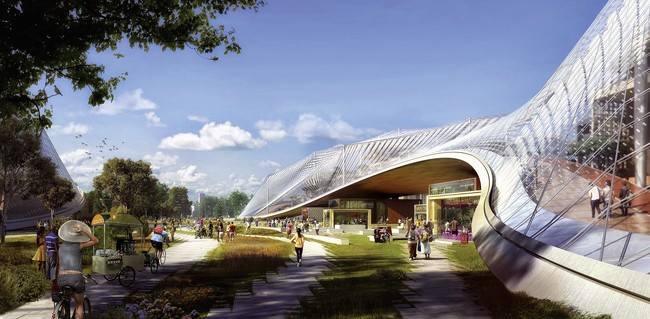The technology sector and Silicon Valley construction have always had a symbiotic relationship. The agreement between companies such as Google and Bay Area development has usually been good, for the most part.
Since the time of Steve Jobs in his garage working to develop the Apple computer, to the hardware revolution that gave the Valley its name, technology has attracted the best, and the brightest to this part of California, and construction usually followed.
The symbiosis between innovation and commercialization have set the West apart to enjoy the rapid increases in private nonresidential construction. This growth is in stark difference to the energy production renaissance of the past, which has slowed. Tech investment, on the other hand, is still growing as consumers buy new products and the U.S. economy has improved since 2008. According to Anirban Basu, the chief economist for the Associated Builders and Contractors, nonresidential construction rose 12.4 percent between September 2014 and September 2015. He predicts a 7.4 percent expansion in nonresidential construction this year.
Desirable Silicon Valley Location

Image NBBJ
The Bay Area region has a long history of allowing tech companies to grow, provided they find ways to mitigate the effects of their expansion. For example, Mountain View, Calif. has become a hotbed of new development from some of the biggest names in tech: Google and LinkedIn. The City received proposals from them, as well as private developers, to add 5.7 million square feet of office space for an area the City had planned to allow just 2.2 million. Palo Alto, Calif., is going through a similar obstacle as Mountain View. Their City Council approved a plan to cap annual office development at just 50,000 square feet. Tech companies opposed the move, saying it was overly restrictive.

The City of San Jose, on the other hand, is welcoming new construction and wants to recruit the tech companies to their South Bay location. They face stiff competition from other Bay Area cities such as Palo Alto, Mountain View, Sunnyvale, and Santa Clara, but hope that the plentiful land on the north side will give them an edge. After about ten years of planning, the transformation of 5,000 acres and $2.8 billion in new projects is coming to North San Jose. Companies such as Samsung that have chosen to build new campuses in North San Jose believe it to be a prime location to recruit top tech talent.
Silicon Valley Construction
From a relocation and development perspective, Silicon Valley construction is on fire right now, and the vast majority of tenant demand (80%) comes from the technology sector. The asking rate for office space has expanded for 16 consecutive quarters–a streak that hasn’t been seen since the dot-com boom days of the 90s. This commercial expansion in the Valley has led to job growth and demand for newly constructed properties in many other Western markets as well. With all this new construction, there will be a need for ancillary construction, such as more retail and residential developments to match the needs of new workers.

For cities like San Jose that want to attract high-profile companies, incentives are the way to go. For example, to encourage more projects and corporate expansion in North San Jose, officials have cut down development fees and red tape for developers and allowed a higher density than what was originally allowed. It makes sense for San Jose, a city that is betting on light rail and new Bay Area Rapid Transit (BART) stations to make it work. Few had been opposed to this massive build-out plan in North San Jose, except for when the neighboring towns of Santa Clara and Milpitas, and Santa Clara County, sued San Jose in 2005 over potential traffic congestion that the new developments would cause for them.
Relationship Challenges
The special relationship between technology and Silicon Valley construction also offers a set of challenges. There is talk about a tech bubble, and according to economist Vikram Mansharamani, one of the indicators that identifies bubbles, usually before they burst, is tall skyscrapers. San Francisco’s new Salesforce Tower development will soon be the tallest building west of the Mississippi, but Salesforce is a company that has never turned an annual profit.

Even if there isn’t a bubble, there’s the dark side of tech behemoths gobbling up office space. For example, Google is rumored to intend to hire 5,000 workers in the Bay Area each year for the next five years. This will expand their offices by millions of square feet. Unfortunately, the race for space is leading to a dramatic rise in the cost of real estate. The rising costs force smaller companies to find new office space of their own, most likely in less expensive areas. There’s also the inevitable strain of the increase in office workers who will overload cities with traffic and make parking, even more difficult.
Because real-estate developers and tech companies fear that any resistance from the community will hinder their growth, they have offered several benefits along with their proposed developments to offset any strain. For example, the companies who want to grow in Mountain View have offered benefits such as added parks to transportation improvements.
For this special relationship between tech and construction to flourish in Silicon Valley, innovation must accompany development for the future. Cities in the Bay Area such as Fremont, Calif. are already pushing for more transit-oriented-development. If more tech workers can live where they work, then fewer will have to drive there. Facebook, for example, is thinking about including residential apartments at its headquarters in a future expansion.Perhaps this will be the way to sustain the symbiosis between tech and new development in the Bay Area, as more and more people come here to live and work in Silicon Valley.
Image Source:
Google’s Plan – Credit: NBBJ

